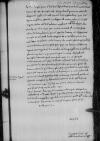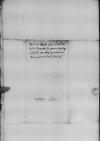Remisit mihi dominus ⌊palatinus Pomeraniae⌋ fasciculum obsignatum sigillo. Cum autem quaererem litteras sigillandas, quas domino ⌊Czema castellano Gdanensi⌋ ad obsignandum mittere volueram, non sunt repertae, scriba enim domini ⌊palatini⌋ neglexit eas in fascem superinscribed⌈in fascemin fascem superinscribed⌉ introligare. Sic famulus Reverendissimae Dominationis Vestrae inane iter metiit. Coactus est meis scriptis redire ad dominum ⌊palatinum⌋, qui, cum offendit, litteras non obsignatas remisit. Cum tamen satis lucide scripseram, et ex exemplari potuit scire, quid litterae in se haberent, credo, incuria scribae omissum esse, cum ipse ⌊palatinus⌋ mala valetudine v correptus forte per se eas litteras seu exemplar vix legerit. Utcumque sit, Reverendissima Dominatio Vestra curabit, ut denique sigilletur.
⌊Castellano Gdanensi⌋ misi litteras Dominationis Vestrae, qui pronunc agit in ⌊Morung⌋, alias sigillasset. Exemplar litterarum apud me retinui, credo Dominationi Vestrae non esse opus. Scribo praeterea ⌊maiestati regiae⌋ de delectu nobilitatis habito ⌊Stargardiae⌋ pro statuto die, feria secunda post Stanislai. ⌊Pomerani⌋ parum oboedientiores fuerunt, quam ⌊Culmenses⌋. Plures se excusabant brevitate temporis. Pauci sunt reperti, qui consulto ad lustrationem non vener(in)t, habita intelligentia cum ⌊Culmensibus⌋. Precor has cum suis dignetur transmittere on the margin⌈Precor has cum suis dignetur transmitterePrecor has cum suis dignetur transmittere on the margin⌉. Dominus ⌊palatinus Culmensis⌋ et capitaneus Grudentinensis signarunt morigeros, sed absentes non notarunt, et hi essent deferendi iuxta mandatum regium.
Cum his me Reverendissimae Dominationi Vestrae unice commendo. Quam felicissime semper ex animo valere cupio.
Litterae ⌊Danorum electi⌋ una cum mandato ⌊Ioannis Pein⌋ sunt apud me. Consultabimus ⌊maiestatem regiam⌋, ubi sunt reponendae. Fortassis mittet eas in ⌊Thorun⌋.
Domino ⌊Nicolao Nycpschicz⌋ respondebo votis suis cum equabus, quamvis multae mihi mortuae sunt.


 BCz 1595, p. 762
BCz 1595, p. 762